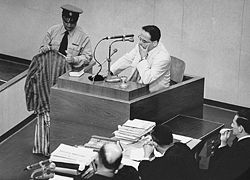- Yehiel De-Nur
-
 Yehiel De-Nur testifies at the trial of Adolf Eichmann.
Yehiel De-Nur testifies at the trial of Adolf Eichmann.
Yehiel De-Nur or Dinur, ('De-Nur' means 'of the fire' in Aramaic), born Yehiel Feiner (16 May 1909 - 17 July 2001) was a Jewish writer and Holocaust survivor, whose books were inspired by his time as a prisoner in the Auschwitz concentration camp.
Contents
Early life
Yehiel De-Nur was born in Sosnowiec (Poland).
Writings at Auschwitz
During World War II De-Nur spent two years as a prisoner in Auschwitz. In 1945, he moved to British-mandate Palestine (later Israel) and became a writer-historian survivor who wrote several works in Hebrew, which stemmed from his experience in the camp, under the identity he had been given by the guards at Auschwitz: Ka-Tzetnik 135633 (sometimes listed as "K. Tzetnik"). Ka-Tzetnik means "Concentration Camper" in Yiddish (deriving from "ka tzet", the pronunciation of KZ, the abbreviation for Konzentrationslager); 135633 was De-Nur's concentration camp number. He also used the name Karl Zetinski (Karol Cetinsky, again. the derivation from "KZ") as a refugee, hence the confusion over his 'real' name when his works were first published.[1]
De-Nur presented his writings as an attempt to chronicle his time at Auschwitz. He wrote using the name Ka-Tzetnik 135633 (which he denied was a pseudonym or pen name but was what his time in Auschwitz had made him) for some time before his civic identity was revealed at the Eichmann Trial at court session 68 of the trial on 7 June 1961.[2] After an opening statement in which De-Nur described Auschwitz as the "planet of the ashes", but before he was able to answer the general questions about Auschwitz that the prosecuting Attorney-General had prepared for him, De-Nur fainted and was subsequently unable to resume his testimony.
The House of Dolls
Among his most famous works was 1955's The House of Dolls,[3] which described the "Joy Division", an alleged Nazi system keeping Jewish women as sex slaves in concentration camps. He suggests that the subject of the book was his younger sister, who did not survive the Holocaust. However, he did not have a sister.[4] In his book Piepel, about Nazi sexual abuse of young boys, he suggests the subject of this book was his younger brother, who also died in a concentration camp.[5]
While De-Nur's books are still a part of the high-school curriculum, young PhD candidate Na'ama Shik more recently has been advancing her hypothesis that The House of Dolls is pornographic fiction,[6] not least because sexual relations with Jews were strictly forbidden to all Aryan citizens of Nazi Germany. This is a controversial issue since forced sexual exploitation of Jewish females and males was a common occurrence despite the Reich's edicts against "interracial" sexual relations.
Its publication is at times pointed to as the inspiration behind the Nazi exploitation genre of serialized cheap paperbacks, known in Israel as Stalag fiction. Their publisher acknowledged the Eichmann trial as the motive behind the series.
The British rock band Joy Division derived its name from this book.
Personal life
Mr Dinur was married to Nina Dinur née Asherman, the daughter of a prominent Tel Aviv doctor. She served in the British Army as a young woman. Nina sought him out after reading his book "Salamandra" and eventually they were married. She was instrumental in the translation and publication of many of his books. They had two children, a son and a daughter, both still living in Israel. She trained with Virginia Satir in the 1970s. Later in life, Nina changed her name to Eliyah Dinur (sometimes spelled De-Nur).
In 1976, because of recurring nightmares and depression, he subjected himself to a form of psychedelic psychotherapy from Dr. Jan Bastiaans that included the use of LSD; the visions experienced during this therapy became the basis for his book, Shivitti.[7] The book's title is derived from David's Psalm 16, "תהילים טז: "שיויתי ה' לנגדי תמיד, more accurately translated in Acts 2:25: "I saw the Lord always before me" etc., or "I was always beholding the Lord in my presence;" etc.
He died of cancer in Tel Aviv on July 17, 2001.
Bibliography
- Atrocity (translated by Nina De-Nur)
- The Clock Above the Head
- The House of Dolls (translated from Hebrew by Moshe M. Kohn)
- Salamandra
- Shivitti: A Vision, ISBN 0-06-250870-9 (From Psalm 16,
- Star Eternal (translated by Nina De-Nur)
- They called Him Piepel
- Kaddish
References
- ^ Who were you, Karl Zetinski?, Tom Segev, Haaretz, July 27, 2001
- ^ The Trial of Adolf Eichmann, Session 68 (Part 1 of 9), Nizkor Project, June 7, 1961
- ^ House of Dolls (Beit ha-bubot), novelguide.com, 2002
- ^ Haaretz.com, Tom Segev, Breaking the Code, Haaretz, April 23, 2009.
- ^ Billwilliams.org
- ^ Israel’s Unexpected Spinoff From a Holocaust Trial, Isabel Kershner, New York Times, September 6, 2007
- ^ Maps.org
External links
Categories:- 1909 births
- 2001 deaths
- Yiddish-language writers
- Polish writers
- Works about the Holocaust
- Polish Jews
- Cancer deaths in Israel
- Holocaust trials
- Holocaust historiography
- The Holocaust in Poland
- Auschwitz concentration camp survivors
- People from Sosnowiec
Wikimedia Foundation. 2010.
